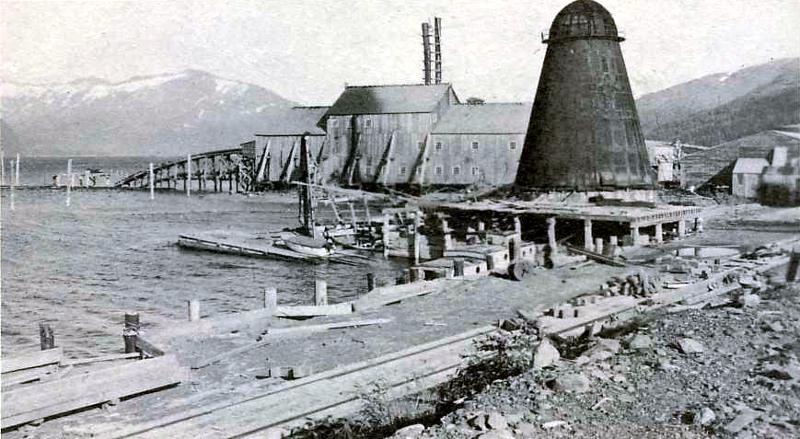Colombia Lumber Company

Photograph from, "The Alaska Railroad" by Bernadine Prince
Colombia Lumber Company operated a steam sawmill
in Whittier Alaska from the mid 1940's until it was destroyed in the 1964 Alaska
earthquake. A 1950 vintage photo was taken from the shoulder of the West Camp
road right alongside the Alaska Railroad main line as it approaches Whittier
Creek at the west end of the Whittier Yard. The creek passes between the slash
burner and the mill.
An early
1944 aerial photo taken from the ocean side shows the mill complex in operation
at the right/west end of the Alaska Railroad yard. The log booms and rafts of
spruce logs can be seen extending into the bay highlighted by the silt laden
fresh water flow from Whittier Creek.
The track in the foreground was the tail of
the siding serving the mill. The dock was used for loading flats with finished
lumber and servicing tow boats and small tugs used to bring log floats of spruce
in from logging operations at remote sites in Prince William Sound. The log
pond was contained behind piling driven into the alluvial gravel bottom beyond
the mill. The bull boat can be seen at the end of the finger pier past the burner.
The boilers were fired with slash and sawdust
with a large squirrel cage fan inducing forced draft through a "dutch oven"
fire box. The bull chain, band saw and some auxiliary pumps and a turbine electrical
generator were steam operated. The green chain, and cut off saws were all electric
powered. Steam heat was piped to the camp dormitory, offices and out buildings
along the yard track off to the right. The entire facility was self contained.
The mill operated seasonally because of the
heavy snows in Whittier. They cut timbers, and dimensional lumber as well as
ties for the Alaska Railroad under contract. There were no drying facilities
in Whittier, and green lumber was shipped by rail to the Colombia Lumber Yard
in Anchorage.
In the late 1950's there was a Coopers Creosote
Plant built inside the Y at Whittier creek. The plant consisted of two large
steel clad tanks and a long retort for cooking ties feed in on rail mounted
carts. They had a contract with the ARR to treat ties cut by the mill across
the tracks.
It all came to an end with the 1964 earthquake.
The mill was destroyed as the alluvial bottom it was attached to shifted. There
is no evidence of the site today, as it has been replaced by the small boat
basin. The new cruise ship dock occupies the space where the old wood dock served
the tow boats.
This account of the mill is based on memories
of playing around the mill in the summer as a kid. The mill manager, Mr. Olson
had his whole family there and little "Richard" and I had the run
of the place. Our favorite activity was riding the bull boat in the log pond.
Exploring the mill and all the steam equipment with the winter caretaker was
an initiation into the marvels of mechanical stuff. In those pre OSHA days,
at 12 or 13 years of age, I had an unpaid education that curious kids today
can only wish for. -- Pat Durand
See also:
- John Pary's WWII photos: 1, 2
Back
Page created 11/15/04 and last updated 1/28/16
